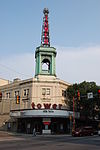
The Southeastern Pennsylvania Transportation Authority (SEPTA) is a regional public transportation authority that operates bus, rapid transit, commuter rail, light rail, and electric trolleybus services for nearly four million people throughout five counties in and around Philadelphia, Pennsylvania. It also manages projects that maintain, replace, and expand its infrastructure, facilities, and vehicles.
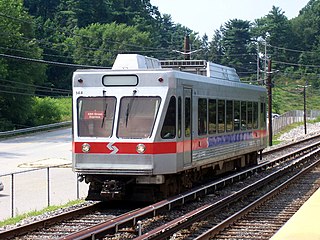
The Norristown High Speed Line (NHSL), currently rebranding as the M, is a 13.4-mile (21.6 km) interurban light rapid transit line in the SEPTA Metro network, running between the 69th Street Transportation Center in Upper Darby and the Norristown Transportation Center in Norristown, Pennsylvania. Service is operated by the Suburban Transit Division of the Southeastern Pennsylvania Transportation Authority. Originally the Philadelphia and Western Railroad line, the line runs entirely on its own right-of-way. By 2020, the Norristown High Speed Line had an average weekday ridership approaching 11,000 passengers.

The Market–Frankford Line (MFL), currently rebranding as the L, is a rapid transit line in the SEPTA Metro network in Philadelphia, Pennsylvania, United States. The MFL runs from the 69th Street Transportation Center in Upper Darby, just outside of West Philadelphia, through Center City Philadelphia to the Frankford Transportation Center in Near Northeast Philadelphia. Starting in 2024, the line was rebranded as the "L" as part of the implementation of SEPTA Metro, wherein line names are simplified to a single letter.

Transportation in Philadelphia involves the various modes of transport within the city and its required infrastructure. In addition to facilitating intracity travel, Philadelphia's transportation system connects Philadelphia to towns of its metropolitan area and surrounding areas within the Northeast megalopolis.

The 69th Street Transportation Center is a SEPTA terminal in the Terminal Square section of Upper Darby Township, Pennsylvania. It serves the Market–Frankford Line, Norristown High Speed Line, and SEPTA Routes 101 and 102 trolleys, and multiple bus routes. It is located at the end of 69th Street, a major retail corridor in Upper Darby Township across Market Street from the Tower Theater. Until 2011, the station was primarily known as 69th Street Terminal.
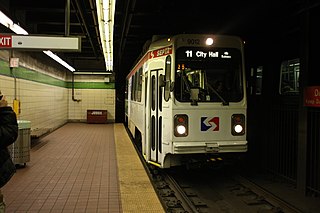
The SEPTA subway–surface trolley lines are a collection of five SEPTA trolley lines that operate on street-level tracks in West Philadelphia and Delaware County, Pennsylvania, and also underneath Market Street in Philadelphia's Center City. The lines, Routes 10, 11, 13, 34, and 36, collectively operate on about 39.6 miles (63.7 km) of route.
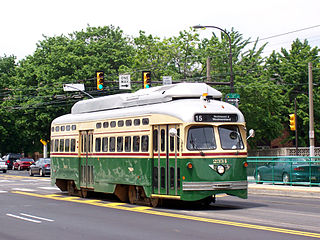
Route 15, currently rebranding as the G, is a street-running light rail line in the SEPTA Metro network that runs along Girard Avenue through North and West Philadelphia, Pennsylvania. Service is operated by the City Transit Division of the Southeastern Pennsylvania Transportation Authority. As of 2024, it is the only trolley line in Philadelphia that is not part of the subway–surface trolley lines. SEPTA PCC III vehicles are used on the line.

SEPTA Route 13, also known as the Chester Avenue Line, is a trolley line operated by the Southeastern Pennsylvania Transportation Authority (SEPTA) that connects 13th Street Station in downtown Philadelphia, Pennsylvania, with Yeadon and Darby, Pennsylvania. It is one of five lines that are part of the Subway-Surface Trolley system. Route 13 will be rebranded as the T3 as part of the transition to SEPTA Metro.

SEPTA's subway–surface trolley route 34, also called the Baltimore Avenue subway line, is a trolley line operated by the Southeastern Pennsylvania Transportation Authority (SEPTA) that connects the 13th Street station in downtown Philadelphia, Pennsylvania, to the Angora Loop station in the Angora neighborhood of West Philadelphia. Route 34 will be rebranded as the T2 as part of the transition to SEPTA Metro.

Pennsylvania Route 3 is a 24.3-mile (39.1 km) state highway located in the southeastern portion of Pennsylvania. The route runs from U.S. Route 322 Business in West Chester east to PA 611 in Philadelphia.

The Southeastern Pennsylvania Transportation Authority operates or contracts operations of these routes serving points in Bucks, Chester, Delaware, and Montgomery counties, with a few routes operating into the city of Philadelphia. The Suburban Transit Division is broken down into three districts: Victory, Frontier, and Contract Operations.

Drexel Hill Junction is a SEPTA Media-Sharon Hill Trolley Line station in Drexel Hill, Pennsylvania. It is located near Hillcrest Road and Shadeland Avenue, and serves both Routes 101 and 102. Drexel Hill Junction is the last stop where Routes 101 and 102 share the same right-of-way.
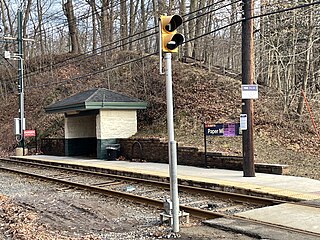
Paper Mill Road station is a SEPTA Route 101 trolley station in Springfield Township, Delaware County, Pennsylvania. It is located on Paper Mill Road at Smedley Park. Smedley Park named after Samuel L. Smedley, the local founder of the Delaware County Parks and Recreation Board.

Fairfield Avenue station is a SEPTA Media-Sharon Hill Trolley Line station in Upper Darby Township, Pennsylvania. It is officially located at Fairfield Avenue and Terminal Square, but the intersection also includes Bywood Avenue, which is a one-way street running west along the lines until the Beverly Boulevard station. The stop serves both Routes 101 and 102. Only local service is provided on both lines. This station is the penultimate stop on the Media-Sharon Hill Trolleys before reaching the 69th Street Terminal. The Upper Darby Post Office can be found on the north side of the station. The parking lot adjacent to the station is privately owned serving mainly a church and an H Mart.

Garrettford station is a SEPTA Route 102 trolley stop in Drexel Hill, Pennsylvania. It is officially located at Edmonds Avenue and Garrett Road, however, the actual location is at the intersection of Edmonds Avenue, Jones Street and Mill Lane, which is south of Garrett Road. The trolley line crosses the aforementioned intersection at the southwest corner of Edmonds Avenue and Jones Street, to the northeast corner of Edmonds Avenue and Mill Lane.
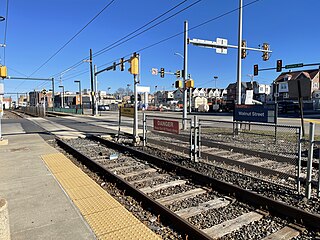
Walnut Street is a SEPTA Media-Sharon Hill Trolley Line stop in Upper Darby Township, Pennsylvania. It is officially located at Garrett Road and Walnut Street, but Bywood Avenue is also included as it parallels the north side of the line. The station serves both Routes 101 and 102, and only local service is provided on both lines. The station contains two platforms with plexiglass bus-type shelters on both sides of the tracks, both of which are at the far end of each platform.

Route 103 is a bus route operated by the Southeastern Pennsylvania Transportation Authority (SEPTA) on the outskirts of Philadelphia, Pennsylvania, United States. Route 103 runs between Ardmore and the 69th Street Transportation Center in Upper Darby.

Irvington Road station is a SEPTA Media-Sharon Hill Trolley Line stop in Drexel Hill, Pennsylvania. It is officially located near Irvington and Hillcrest Roads, but in reality it is nearly halfway between Hillcrest and Garrett Roads on Irvington Road. It serves both Routes 101 and 102, and only local service is provided on both lines. Irvington Road is the next to last stop where Routes 101 and 102 share the same right-of-way.

Drexel Park station is a SEPTA Media-Sharon Hill Trolley Line stop in Drexel Hill, Pennsylvania. It is located on Fairfax Road between Hillcrest and Garrett Roads and serves both Routes 101 and 102. Only local service is provided on both lines.

SEPTA Metro is an urban rail transit network in and around Philadelphia, Pennsylvania, United States, operated by the Southeastern Pennsylvania Transportation Authority (SEPTA). The network includes two rapid transit lines, a light rapid transit line, a surface-running trolley line, and a subway–surface trolley line, totaling 78 miles (126 km) of rail service.




























